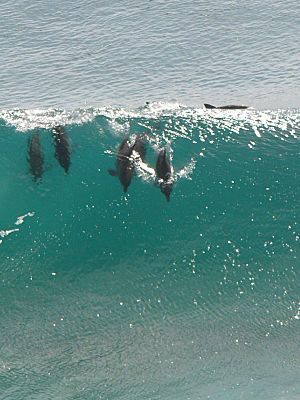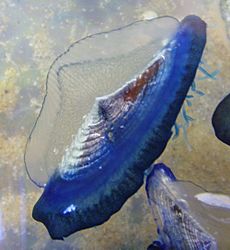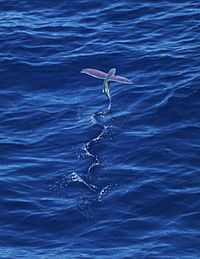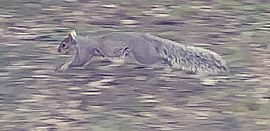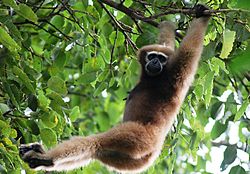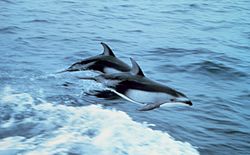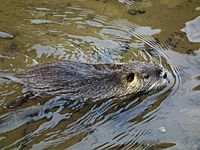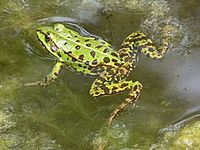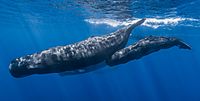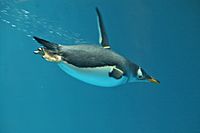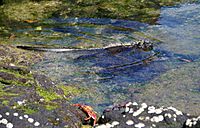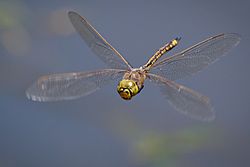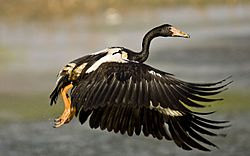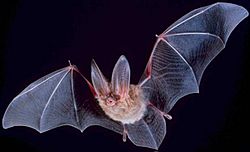Animal locomotion facts for kids
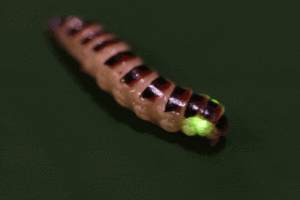
Animal locomotion is all about how animals move from one place to another. Some animals move by themselves, like when they run, swim, jump, or fly. Other animals get around by using their environment. This is called passive locomotion. For example, some jellyfish sail with the currents, spiders use the wind to "kite," and some animals even ride on other animals!
Animals move for many important reasons. They might be looking for food, a mate, or a good place to live. They also move to escape predators. Being able to move is super important for an animal's survival. Over time, natural selection has helped animals develop amazing ways to move. For instance, animals that travel very long distances, like the Arctic tern, have ways of moving that use very little energy. But animals that need to escape quickly from danger might have fast, but energy-costly, ways of moving.
The body parts animals use for moving are called locomotory organs. These can be tiny hairs, legs, wings, arms, fins, or tails.
Contents
What Does Locomotion Mean?
The word "locomotion" comes from Latin words. Loco means "from a place," and motio means "motion" or "a moving." So, it literally means "moving from a place."
Moving in Different Places
Animals move in or on four main types of environments:
- Water: This includes moving in or on the water.
- Land: This means moving on the ground, or even in trees (called arboreal).
- Underground: Some animals live and move below the surface.
- Air: This is for animals that fly.
Many animals, like diving birds, move through more than one type of environment regularly. Sometimes, the surface an animal moves on helps it get around.
Moving in Water
Swimming Underwater
In water, animals can float if their body is less dense than the water. This saves energy for staying upright. However, moving forward in water takes a lot of energy because water creates more drag (resistance) than air. So, having the right body shape is key for swimming well, especially for catching food. Many water animals have a sleek, torpedo-like body shape.
Most fish swim by wiggling their bodies from side to side. This creates a wave-like motion that ends at their large tail fin, pushing them forward. For slower movements, fish often use their pectoral fins (front fins). Some fish, like skates and rays, use their pectoral fins as their main way to move. Marine mammals, like dolphins, move their bodies up and down to swim.
Other animals, like penguins, move underwater almost like they are flying. Some fish, like seahorses, swim without wiggling their bodies much.
Cephalopods (like squid and octopuses) use jet propulsion to move fast. They suck in water and then squirt it out quickly in a powerful burst. Other swimming animals, like humans, mostly use their limbs to swim. Even though life started in the oceans, many land animals have returned to living in water, like whales and dolphins.
Dolphins sometimes ride the waves made by boats or surf on natural ocean waves.
Moving on the Water Surface
The Velella, also known as the by-the-wind sailor, is a sea creature that can only move by sailing. It has a small, stiff sail that sticks up into the air and catches the wind. Velella always line up with the wind, so they tend to sail downwind.
While big animals like ducks float on water, some small animals can move across the surface without breaking through it. They use the surface tension of the water. Water striders are an example. Their legs are water-repelling, which helps them stay on top of the water. Another animal that moves on the surface, but breaks through it, is the basilisk lizard. It can run across water!
Moving on the Seabed
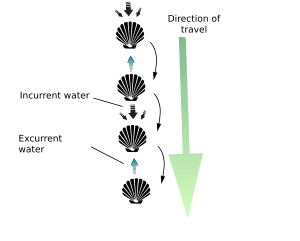
Benthic locomotion is how animals move on or near the bottom of the ocean or other water bodies. Many sea animals walk along the seabed. Echinoderms, like starfish and sea urchins, mostly use their tube feet to move. These tube feet have a suction-cup-like tip that helps them stick to surfaces. They move slowly by contracting and relaxing their tube feet in waves. Some sea urchins also use their spines to move along the bottom.
Crabs usually walk sideways. This is because of how their legs are built, which makes walking sideways easier for them. However, some crabs can walk forward or backward. Some crabs, like swimming crabs, can also swim because their last pair of walking legs are flat like paddles.
One type of mantis shrimp, Nannosquilla decemspinosa, can escape danger by rolling itself into a wheel and somersaulting backward very fast. It can travel over 2 meters this way!
Moving in the Air
Active Flight
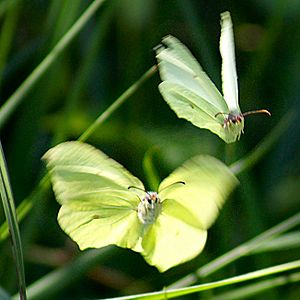
The biggest challenge for flying animals is gravity. Since no animal can be lighter than air, flying animals must create enough lift to get off the ground and stay in the air. They do this with wings. When wings move through the air, they create an upward force. Flying animals need to be very light. The largest flying birds today weigh about 20 kilograms. Flying animals also have light bodies, sleek shapes, and strong flight muscles.
Active flight has developed separately at least four times in history: in insects, pterosaurs, birds, and bats. Insects were the first to fly, about 400 million years ago. Pterosaurs came next (around 220 million years ago), then birds (about 160 million years ago), and finally bats (about 60 million years ago).
Gliding
Instead of active flight, some animals that live in trees can glide to slow their fall. Gliding is like flying without using flapping power. It means flying a longer distance horizontally than vertically, so it's not just like falling with a parachute. Gliding has developed many more times than active flight. There are gliding animals among insects (like gliding ants), reptiles (like banded flying snakes), amphibians (like flying frogs), and mammals (like sugar gliders).
Some water animals also glide, such as flying fish and some squid. Flying fish usually glide about 50 meters, but they can use air currents from waves to go up to 400 meters! To launch out of the water, a flying fish wiggles its tail up to 70 times per second.
Several types of oceanic squid also jump out of the water to escape predators, similar to flying fish. Smaller squid can fly in groups and have been seen covering distances of 50 meters. They use small fins to help them stay steady in the air. They launch themselves by shooting water out of a funnel. Some squid even keep jetting water while airborne, which might make them the only animals with jet-propelled flight!
Soaring
Soaring birds can stay in the air without flapping their wings. They use rising air currents. Many soaring birds can "lock" their wings open with a special tendon. Soaring birds might glide for a while and then soar in rising air. They use different types of rising air, like warm air currents (thermals), air pushed up by hills (ridge lift), or air currents over the sea.
Examples of soaring birds include:
- Vultures using thermals.
- Gulls using ridge lift near cliffs.
- Albatrosses using air currents near the ocean surface.
Ballooning
Ballooning is how spiders move through the air. Small or young spiders release special, lightweight silk threads into the air. These threads form a parachute that carries the spider on wind currents, sometimes for very long distances and high up!
Moving on Land
Forms of movement on land include walking, running, hopping, jumping, dragging, and crawling. On land, friction is important, but floating is not. Animals need strong bones and muscles for support. Each step also takes energy to start moving, but animals can store energy in their tendons to help. Balance is also very important for moving on land.
Human babies first learn to crawl before they can stand and walk on two feet. This needs good coordination and physical growth. Humans are bipedal, meaning we walk on two legs. When we walk, one foot is always on the ground. When we run, both feet leave the ground for a short time. At faster speeds, momentum helps us stay upright.
Jumping
Jumping (also called saltation, hopping, or leaping) is different from running because the animal stays in the air for a longer time and launches at a higher angle. Many land animals jump to escape predators or catch food. However, only a few animals use jumping as their main way to move. These include kangaroos, rabbits, hares, and jerboas. Kangaroo rats can leap 2 meters and even up to 2.75 meters! They can also change direction quickly while jumping. Frogs are the best jumpers among all vertebrates (animals with backbones) for their size. The Australian rocket frog can leap over 2 meters, which is more than 50 times its own body length!
Crawling and Looping

Some animals move on land without legs. Earthworms crawl by using a wave-like motion of their bodies, similar to how food moves through your digestive system. This is called peristalsis.
Leeches and geometer moth caterpillars move by "looping" or "inching." They use muscles to stretch forward, attach their front end, then pull their back end forward. Leeches use suckers at both ends of their body to do this.
Sliding
Ice is very slippery, which allows for different ways of moving. Penguins can waddle on their feet or slide on their bellies across the snow. This sliding is called tobogganing and saves energy while moving fast. Some seals do something similar called sledding.
Climbing
Some animals are specially built for moving on surfaces that are not flat, like trees or rocks. Climbing animals often live in trees. For example, gibbons are excellent climbers and swing quickly from branch to branch using only their arms. This is called brachiation.
Animals that live on steep rock faces, like in mountains, move by carefully balancing and leaping. Mountain goats are amazing climbers. They have soft, rubbery pads on their hooves for grip and sharp hoof edges to hold onto small footholds. Snow leopards, which hunt these goats, also have incredible balance and can leap up to 17 meters!
Some light animals can climb smooth, flat surfaces or hang upside down using suckers for grip. Many insects can do this, and even larger animals like geckos can climb walls.
Walking and Running with Legs
Animals have different numbers of legs, which leads to many ways of moving.
Modern birds usually have only two legs. Some, like ostriches, use these two legs as their main way to move. A few mammals also walk on two legs, like kangaroos and kangaroo rats. Octopuses can even walk on two arms on the seabed, using their other arms to hide!
There are no animals that normally walk on three legs. However, kangaroos sometimes use their strong tails as a "fifth limb" for support when grazing.
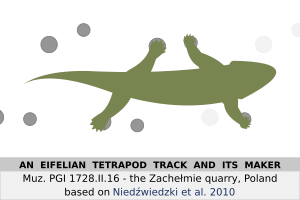
Many common animals, like dogs and cats, are quadrupedal, meaning they walk or run on four legs. Some birds, like the newly hatched hoatzin, have claws on their wings to climb trees until they can fly.
Insects usually walk with six legs, though some butterflies don't use their front legs for walking.
Arachnids (like spiders and scorpions) have eight legs. Many spiders extend their legs using blood pressure, not just muscles. Scorpions use a special alternating pattern with their legs to walk.
Centipedes and millipedes have many legs that move in a wave-like pattern. Some echinoderms, like starfish, use their many tube feet on their underside to move. These tube feet stick to surfaces using special chemicals. Most starfish move slowly, but some, like the sunflower seastar, can move up to 1 meter per minute using 15,000 tube feet!
Many animals can change how many legs they use to move depending on the situation. For example, many four-legged animals might stand on two legs to reach food in trees. Basilisk lizards usually walk on four legs in trees. But if they get scared, they can run across water on their two hind legs for a short distance! Cockroaches can also run on their two hind legs at very high speeds.
Powered Cartwheeling
The Moroccan flic-flac spider can move by doing fast, acrobatic flips with its legs, like a gymnast. This allows it to roll both downhill and uphill, even on a steep slope. This is different from other spiders that just roll passively down hills. The flic-flac spider can reach speeds of 2 meters per second using these flips to escape danger.
Moving Underground
Some animals move through soft ground, like soil, by burrowing. Earthworms do this using their wave-like body movements (peristalsis). In loose sand, animals like golden moles can move very quickly, almost "swimming" through the sand. Other burrowing animals include moles, naked mole-rats, and mole crickets.
Moving in Trees
Arboreal locomotion is how animals move in trees. Some animals only climb trees sometimes, while others live only in trees. Moving in trees is challenging and has led to many special body features and behaviors in animals. These ideas also apply to climbing on rocks or mountains. The earliest known four-legged animal adapted for climbing trees was Suminia, about 260 million years ago. Some insects and snails also live only in trees.
Brachiation is a way of moving where primates swing from tree branch to tree branch using only their arms. This is the main way small gibbons and siamangs move. Some monkeys in the New World, like spider monkeys, are "semibrachiators," meaning they combine leaping and swinging. Some also use their prehensile tail (a tail that can grip) like a fifth hand.
How Animals Use Energy to Move
Moving takes energy for animals to overcome different forces like friction, drag (resistance), inertia (the tendency to stay still or keep moving), and gravity. How much these forces affect an animal depends on where it's moving.
On land, animals need to fight gravity, but air resistance is usually small. In water, drag is the biggest challenge, and gravity is less of a problem. Animals that naturally float in water use little energy to stay upright. Those that sink must use energy to stay afloat. Drag is also important for flight, which is why flying birds have sleek, efficient body shapes. Animals without legs moving on land need energy to overcome surface friction, but not much to fight gravity.
Newton's third law of motion helps us understand animal movement: to move forward, an animal must push something backward. Land animals push the ground. Swimming and flying animals push against a fluid (water or air). The energy animals use for movement is called energetics. Animals usually try to use the least amount of energy possible when moving. However, when escaping a predator, speed is more important than saving energy, so these movements can use a lot of power.
Scientists often measure energy use by how much oxygen an animal breathes in or how much carbon dioxide it breathes out. For land animals, this is often measured on a treadmill. Swimming is the most energy-efficient way to travel over a distance, followed by flying, and then walking/running on land. However, because flying is so fast, it uses the most energy per minute. Heavier animals use more total energy to move, but less energy per kilogram of their body weight.
Passive Locomotion
Passive locomotion is when an animal moves because its environment carries it. These animals can change their location but don't actively move themselves.
Hydrozoans
The Portuguese man o' war lives on the ocean surface. It has a gas-filled float that stays above water, while the rest of its body is submerged. Since it can't move itself, it relies on winds, currents, and tides to travel. It can deflate its float to briefly sink if attacked.
Mollusks
The violet sea-snail floats on the ocean surface using a raft of bubbly foam that it creates.
Spiders
The wheel spider from the Namib Desert can escape parasitic wasps by flipping onto its side and cartwheeling down sand dunes very fast, up to 44 turns per second! It can roll 1 meter per second down a slope.
Small or young spiders use "ballooning." They climb as high as they can, stand on their tiptoes, and release several silk threads into the air. These threads form a parachute that carries the spider on wind currents, sometimes for long distances.
Insects
The larva of the eastern beach tiger beetle can leap into the air, curl its body into a wheel, and roll along the sand very fast, using the wind to push it. If the wind is strong, it can roll up to 60 meters! This might help it escape predators.
Fleas can jump very high (up to 18 cm vertically) and far (up to 33 cm horizontally). While the flea starts the jump, it has little control over where it goes once it's in the air.
Crustaceans
One type of mantis shrimp, Nannosquilla decemspinosa, can flip itself into a crude wheel. It lives in shallow, sandy areas. When the tide is low, its short legs aren't good for moving on dry land. So, it does a forward flip to roll towards the next tide pool. It can roll for 2 meters, but usually travels less than 1 meter. Like the flea, the animal starts the movement but has little control once it's rolling.
Animal Transport
Sometimes, animals change location because they are attached to or live on another animal or a moving object. This is called "animal transport."
Remoras
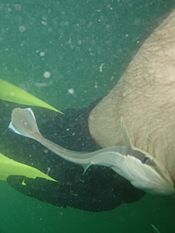
Remoras are fish that grow up to 90 cm long. They have a special sucker-like organ on their heads, which is a changed dorsal fin. This organ creates suction, allowing them to firmly attach to the skin of larger marine animals. By sliding backward, the remora can increase the suction. It can release itself by swimming forward. Remoras can swim well on their own.
Remoras often attach to sharks, manta rays, whales, turtles, and dugongs. Smaller remoras might attach to tuna or swordfish, or even travel inside the mouths or gills of large rays and fish. The remora benefits by getting a free ride and protection. It also eats scraps of food dropped by its host.
Anglerfish
In some types of anglerfish, when a male finds a female, he bites into her skin. He releases a special chemical that makes his mouth skin and her body skin join together, even connecting their blood vessels. The male then depends on the female for food through their shared blood system. He grows larger and stays able to reproduce as long as the female lives. This extreme difference between male and female ensures that when the female is ready to lay eggs, she has a mate right there.
Parasites
Many parasites are carried by their hosts. For example, tapeworms live inside other animals' digestive systems. They rely on the host's movement to spread their eggs. External parasites, like fleas, can move on their host's body, but the host's movement carries them much farther. Some external parasites, like lice, might even hitch a ride on a fly to find a new host.
Changing How They Move
Some animals move between different environments, like from water to air. This often means they need different ways of moving in each place and a special way to switch between them.
Many animals are semi-aquatic, meaning they spend part of their lives in water. These include mammals (like beavers and otters), birds (like penguins and ducks), reptiles (like anacondas), and amphibians (like frogs).
Fish
Some fish use many ways to move. Walking fish can swim freely or "walk" along the ocean or river floor, but not on land. Amphibious fish can leave the water for long periods. They use different ways to move on land, like wiggling their bodies, walking with their fins and tail, or jumping. Examples include eels and mudskippers. Flying fish can make powerful leaps out of the water into the air. Their long, wing-like fins let them glide for long distances above the water. This is a natural way to escape predators. Flying fish usually glide about 50 meters, but they can use air currents from waves to cover up to 400 meters. They can travel over 70 km/h!
Marine Mammals
When swimming, many marine mammals like dolphins and seals often leap above the water while still moving forward. This is called "porpoising." They do this for different reasons. When traveling, jumping can save energy because there's less friction in the air. Dolphins also porpoise to find their way, show off, fight, communicate, or just for fun. Seals might porpoise to find their way to shore or to look out for predators like sharks.
Some whales lift their whole bodies vertically out of the water. This is called "breaching."
Birds
Some semi-aquatic birds can walk on land, swim on the surface, swim underwater, and fly (like ducks and swans). Diving birds also dive underwater. Some birds, like ostriches, have lost the ability to fly. Ostriches are the fastest two-legged animals in the world, reaching speeds over 70 km/h when chased! They can also swim. Penguins either waddle on their feet or slide on their bellies across the snow (tobogganing) to save energy and move quickly. They also jump with both feet together to move faster or cross rough ground. To get onto land from the water, penguins sometimes launch themselves upward at great speed to leap out.
Changes During Life
An animal's way of moving can change a lot during its life. Barnacles live only in the ocean. They have two stages where they actively swim as larvae. But as adults, they are sessile (they stay in one place) and filter food from the water. Often, adult barnacles attach to moving objects like whales or ships, and then they are carried around the oceans (passive locomotion).
Why Animals Move
Animals move for many reasons, like finding food, a mate, a good place to live, or to escape predators.
Finding Food
Animals use movement in many ways to find food. On land, they might hide and wait for prey (ambush predation), hunt in groups, or graze on plants. In water, they might filter food from the water, graze, or use special feeding methods. Some animals are also parasites that live on or in other animals and get food from them.
Galleries
- Swimming in major groups of formerly terrestrial animals
-
Coypu (Rodentia)
-
Frog (Anura)
-
Sperm whales (Cetacea)
-
Gentoo penguin (Aves)
-
Marine iguana (Reptilia)
- Flight in major groups
See Also
 In Spanish: Locomoción animal para niños
In Spanish: Locomoción animal para niños


